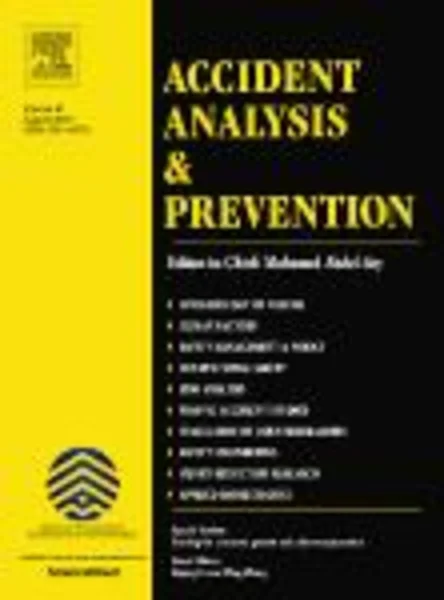-
road safety risk evaluation and target setting using data envelopment analysis and its extensions
جزئیات بیشتر مقاله- تاریخ ارائه: 1392/01/01
- تاریخ انتشار در تی پی بین: 1392/01/01
- تعداد بازدید: 591
- تعداد پرسش و پاسخ ها: 0
- شماره تماس دبیرخانه رویداد: -
currently, comparison between countries in terms of their road safety performance is widely conducted in order to better understand one's own safety situation and to learn from those best-performing countries by indicating practical targets and formulating action programmes. in this respect, crash data such as the number of road fatalities and casualties are mostly investigated. however, the absolute numbers are not directly comparable between countries. therefore, the concept of risk, which is defined as the ratio of road safety outcomes and some measure of exposure (e.g., the population size, the number of registered vehicles, or distance travelled), is often used in the context of benchmarking. nevertheless, these risk indicators are not consistent in most cases. in other words, countries may have different evaluation results or ranking positions using different exposure information. in this study, data envelopment analysis (dea) as a performance measurement technique is investigated to provide an overall perspective on a country's road safety situation, and further assess whether the road safety outcomes registered in a country correspond to the numbers that can be expected based on the level of exposure. in doing so, three model extensions are considered, which are the dea based road safety model (dea-rs), the cross-efficiency method, and the categorical dea model. using the measures of exposure to risk as the model's input and the number of road fatalities as output, an overall road safety efficiency score is computed for the 27 european union (eu) countries based on the dea-rs model, and the ranking of countries in accordance with their cross-efficiency scores is evaluated. furthermore, after applying clustering analysis to group countries with inherent similarity in their practices, the categorical dea-rs model is adopted to identify best-performing and underperforming countries in each cluster, as well as the reference sets or benchmarks for those underperforming ones. more importantly, the extent to which each reference set could be learned from is specified, and practical yet challenging targets are given for each underperforming country, which enables policymakers to recognize the gap with those best-performing countries and further develop their own road safety policy.
مقالات جدیدترین رویدادها
-
استفاده از تحلیل اهمیت-عملکرد در ارائه الگوی مدیریت خلاقیت سازمانی و ارائه راهکار جهت بهبود
-
بررسی تاثیر ارزش وجوه نقد مازاد بر ساختار سرمایه شرکت های پذیرفته شده در بورس اوراق بهادار تهران
-
بررسی تأثیر سطح افشای ریسک بر قرارداد بدهی شرکت های پذیرفته شده در بورس اوراق بهادار تهران
-
بررسی تأثیر رتبه بندی اعتباری مبتنی بر مدل امتیاز بازار نوظهور بر نقد شوندگی سهام با تأکید بر خصوصی سازی شرکت ها
-
تأثیر آمیخته بازاریابی پوشاک ایرانی بر تصویر ذهنی مشتری پوشاک ایرانی (هاکوپیان)
-
بررسی حوزه تأثیر مدیریت استراتژیک در طراحی سیستم اطلاعات مدیریت پروژه بر اساس مدل m (مطالعه موردی: شرکت ماشین سازی اراک)
-
بررسی نقش مخزن سد لتیان در تله اندازی رسوب
-
اثر بخشی شناخت درمانی گروهی مبتنی بر ذهن آگاهی بر بهبود کیفیت زندگی مادران کودکان دارای اختلال کمبود توجه و بیش فعالی (adhd) جزیره قشم
-
ارزیابی استهلاک انرژِی در اتصالات روی هم به وسیله ای پیچ اصطکاکی تحت بارگذاری چرخه ای
-
سواد هیجانی، مفهومی زیر ساختی و فراموش شده در آموزش
مقالات جدیدترین ژورنال ها
-
مدیریت و بررسی افسردگی دانش آموزان دختر مقطع متوسطه دوم در دروان کرونا در شهرستان دزفول
-
مدیریت و بررسی خرد سیاسی در اندیشه ی فردوسی در ادب ایران
-
واکاوی و مدیریت توصیفی قلمدان(جاکلیدی)ضریح در موزه آستان قدس رضوی
-
بررسی تاثیر خلاقیت، دانش و انگیزه کارکنان بر پیشنهادات نوآورانه کارکنان ( مورد مطالعه: هتل های 3 و 4 ستاره استان کرمان)
-
بررسی تاثیر کیفیت سیستم های اطلاعاتی بر تصمیم گیری موفق در شرکتهای تولیدی استان اصفهان (مورد مطالعه: مدیران شرکتهای تولیدی استان اصفهان)
-
میانجی گری از منظر کیفرشناسی در نظام حقوقی ایران
-
بررسی نقش پدافند غیرعامل در مدیریت شهری (مطالعه موردی: شهر رشت)
-
تاثیر محدودیت های مالی بر عملکرد مالی شرکت های پذیرفته شده در بورس اوراق بهادار تهران
-
نقش برند سازی بر ایجاد یک تصویر ماندگار از شهر اصفهان در بین توریست ها
-
بررسی رابطه بین قابلیت مقایسه صورت های مالی و نگهداشت وجه نقد در شرکت های پذیرفته شده در بورس اوراق بهادار تهران




سوال خود را در مورد این مقاله مطرح نمایید :